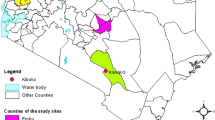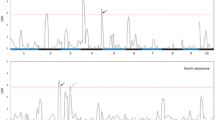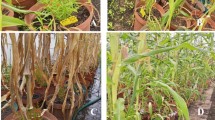Abstract
Mediterranean corn borer (MCB) (Sesamia nonagrioides Lef) and European corn borer (ECB) (Ostrinia nubilalis Hbn) are the most important biotic stresses of maize in Europe. The first selection program to improve stalk resistance to MCB was carried out in the maize population EPS12. It has shown that selection was effective to improve stalk resistance to MCB and ECB, while yield was not significantly diminished. The objective of this research was to determine if correlated changes in EPS12 occurred due to selection for resistance to MCB. Cycles of selection per se and testcrosses to three testers were evaluated under MCB and ECB artificial infestation at two different Spanish locations during 2 years. Selection has significantly reduced cob damage, days to silking, plant and ear height, and 100-kernel weight; meanwhile early vigor was increased. These changes could rather be a consequence of unconscious selection and/or the genetic correlation of these traits with resistance than a consequence of genetic drift.
Similar content being viewed by others
References
Anglade P, Gouesnard B, Boyat A, Panouillé A (1996) Effects of multitrait recurrent selection for European corn borer tolerance and for agronomic traits in FS12 maize synthetic. Maydica 41:97–104
Butrón A, Malvar RA, Cartea ME, Ordás A, Velasco P (1999a) Resistance of maize inbreds to pink stem borer. Crop Sci 39:102–107
Butrón A, Malvar RA, Velasco P, Vales MI, Ordás A (1999b) Combining abilities for maize stem antibiosis, yield loss, and yield under infestation and no infestation with pink stem borer attack. Crop Sci 39:691–696
Butrón A, Widstrom NW, Snook ME, Wiseman BR (2000) Recurrent selection for corn earworm resistance in three corn synthetics. Maydica 45:295–300
Butrón A, Tarrío R, Revilla P, Ordás A, Malvar RA (2005) Molecular changes in the maize composite EPS12 during selection for resistance to pink stem borer. Theor Appl Genet 6:1044–1051
Butrón A, Sandoya G, Santiago R, Ordás A, Rial A, Malvar RA (2006a) Searching for new sources of pink stem borer resistance in maize (Zea mays L). Genet Resour Crop Evol 53:1455–1462
Butrón A, Santiago R, Mansilla P, Pinto-Varela C, Ordás A, Malvar RA (2006b) Maize (Zea mays L) genetic factors for preventing fumonisin contamination. J Agric Food Chem 54:6113–6117
Butrón A, Revilla P, Sandoya G, Ordás A, Malvar RA (2009) Resistance to reduce corn borer damage in maize for bread in Spain. Crop Prot 28:134–138
Carmer SG, Seif RD (1963) Calculation of orthogonal coefficients when treatments are unequally replicated and/or unequally spaced. Agron J 55:387–389
Cordero A, Malvar RA, Butrón A, Velasco P, Revilla P, Ordás A (1998) Population dynamics and life-cycle of corn borers in South Atlantic European coast (Lepidoptera, Noctuidae, Pyralidae). Maydica 43:5–12
Eizaguirre M, Albajes R (1992) Diapause induction in the stem corn borer, Sesamia nonagrioides (Lepidoptera: Noctuidae). Entomol Gen 17:277–283
Grier SL, Davis DW (1980) Infestation procedures and heritability of characters used to estimate ear damage caused by second-brood European corn borer (Ostrinia nubilalis Hübner) on corn. J Am Soc Hortic Sci 105:3–8
Johnson HW, Robinson HF, Comstock RE (1955) Genotypic and phenotypic correlations in soybeans and their implications in selection. Agron J 47:477–483
Klenke JR, Russell WA, Guthrie WD (1986) Recurrent selection for resistance to European corn borer in a corn synthetic and correlated effects on agronomic traits. Crop Sci 26:864–868
Malvar RA, Cartea ME, Revilla P, Ordás A, Alvarez A, Mansilla JP (1993) Sources of resistance to pink stem borer and European corn borer in maize. Maydica 38:313–319
Muñoz L, Cardelle M, Pereiro M, Riguera M (1990) Occurrence of corn mycotoxins in Galicia (northwest Spain). J Agric Food Chem 38:1004–1006
Nyhus KA, Russell WA, Guthrie WD (1989) Changes in agronomic traits associated with recurrent selection in two corn synthetics. Crop Sci 29:269–275
Ordás A (1991) Heterosis in crosses between American and Spanish populations of maize. Crop Sci 31:931–935
Ordás B, Malvar RA, Santiago R, Butrón A (2010) QTL mapping for Mediterranean corn borer resistance in European flint germplasm using recombinant inbred lines. BMC Genomics 11:174. doi:10.1186/1471-2164-11-174
Pounders CT Jr, Davis DW, Windels MB, Chiang HC (1975) Resistance to second-brood European corn borer attack in dent inbred ‘B52’ and in progeny from crosses with four sweet corn inbreds. J Am Soc Hortic Sci 100:101–103
Revilla P, Butrón A, Malvar RA, Ordás A (1999) Relationships among kernel weight, early vigor and growth in maize. Crop Sci 39:654–658
Russell WA, Lawrence GD, Guthrie WD (1979) Effects of recurrent selection for European corn borer resistance on other agronomic characters in synthetic cultivars of corn. Maydica 24:33–47
Sandoya G, Butrón A, Alvarez A, Ordás A, Malvar RA (2008) Direct response of a maize synthetic to recurrent selection for resistance to stem borers. Crop Sci 48:113–118
Sandoya G, Malvar RA, Revilla P, Butrón A (2009) Effects of selection for maize resistance to Sesamia nonagrioides on the additive and dominant components of genetic variance. Plant Breed 128:244–248
SAS (2007) The SAS system. SAS online doc HTML format 8 version. SAS Institute Inc, Cary
Steel RGD, Torrie JH (1980) Principles and procedures of statistic in biological research, 2nd edn. McGraw Hill, New York
Vales MI, Malvar RA, Revilla P, Ordás A (2001) Recurrent selection for grain yield in two Spanish maize synthetic populations. Crop Sci 41:15–19
Velasco P, Revilla P, Monetti L, Butrón A, Ordás A, Malvar RA (2007) Corn borers (Lepidoptera: Noctuidae, Crambidae) in Northwestern Spain: population dynamics and distribution. Maydica 52:195–203
Acknowledgments
Research supported by the Plan Nacional I+D+I (AGL2003-00961 and AGL2006-1314). G. Sandoya acknowledges a fellowship from the Ministry of the Education and Science that allowed him to carry out this study; part of this study is a thesis by the senior author for the Ph.D. degree. Authors thank Raquel Díaz and Emma Muiñoz for rearing insects. Also thank to the whole field team at Misión Biológica de Galicia for field work.
Author information
Authors and Affiliations
Corresponding author
Rights and permissions
About this article
Cite this article
Sandoya, G., Butrón, A., Santiago, R. et al. Indirect response to selection for improving resistance to the Mediterranean corn borer (Sesamia nonagrioides Lef) in maize. Euphytica 176, 231–237 (2010). https://doi.org/10.1007/s10681-010-0232-x
Received:
Accepted:
Published:
Issue Date:
DOI: https://doi.org/10.1007/s10681-010-0232-x




